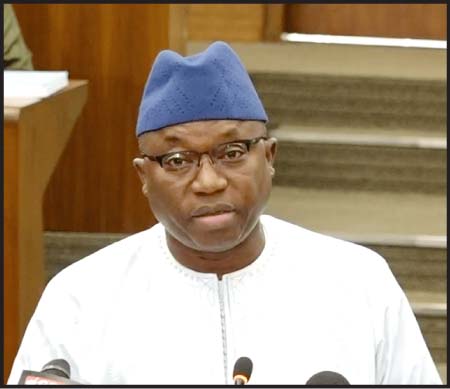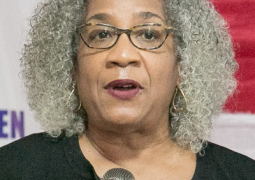
Finance minister talks about how Gambia, V20s are doing to stem effects of climate change & disasters
Priorities of V20 for climate and disaster risk finance and insurance
The Vulnerable 20 (V20) Group of Ministers of Finance is a key partner of ISF. In the first V20 Climate Vulnerables Finance Summit, the need for a global public-private partnership for risk analysis and resilience was communicated. Thus, with its approach to leverage, the expertise and capacities of the private sector in analysing and managing climate and disaster risks ISF addresses the needs ofthe V20 and its member countries.
H.E. Mambury Njie, Minister of Finance and Economic Affairs of The Gambia was interviewed by the Insurelience Solution Fund (ISF) on the need to improve access to data and modelling for vulnerable countries and fostering local capacities.
Qu:What measures are member states of the V20 implementing to reduce and manage the impacts of climate change? Which measures should be prioritized?
Njie: Member states of the V20, especially the most vulnerable communities, are already paying for climate impacts. However, measures are being implemented across the V20 to reduce and manage the impacts of climate change. Some of our members have access to regional risk pools, contingency financing, and micro solutions. For the past five years, The Gambia, for example, has participated in a regional risk pool on drought to protect its vulnerable farming community. Nevertheless, financing the insurance premium has proven a significant challenge for the government. As such, financial protection tools must overcome significant barriers in terms of affordability and investment in order to be effective in reducing and managing the impacts of climate change. Further measures to be prioritized include:
- The development of domestic financial insurance markets through investment in capacity, South-South learning and exchanges in product development. The V20’s Sustainable Insurance Facility focuses on micro, small and medium enterprises because they are dynamic, represent a major share of all climate risk exposure in the V20, and can act as engines for the growth of this new market.
- Time-bound subsidization strategies to be available in a systematic way so that climate and disaster risk financing products can gain sufficient market scale and thus generate sustainable internal momentum. For as long as market scale remains small, financial protection products will be largely unaffordable, halting market growth in its tracks.
- Climate-vulnerable finance and V20 Climate Prosperity Plans will become critical tools for strategizing actions and investments needed to ensure more resilient economies while maintaining high growth and maximizing V20 contributions to the Paris Agreement.
- Creation of special financial assistance and crisis support, which the IMF’s Resilience and Sustainability Trust can facilitate.The V20 face very high capital costs due to a variety of country-related risks, one of which is increasing climate risks. Capital cost hurdles are one of the greatest impediments to our resilient and sustainable development. Access to lower cost of capital can improve debt sustainability and allow sustainable and resilient investments to succeed. Support for initiatives such as the V20-led Accelerated Financing Mechanism can provide off-balance sheet de-risking tools to reduce the cost of capital to build climate resilience.
- The most vulnerable communities do not have access to resources. We need a global protection shield for the most vulnerable to deal with loss and damage.
- We furthermore advocate for greater priority, accessibility, and affordability of climate and disaster risk finance and insurance for the most vulnerable. This requires the development of a global disaster risk finance architecture that prioritizes disaster risks sharing among the most vulnerable developing and low-income countries, as well as developed economies.
Qu: The need to integrate climate and sustainable development objectives and improve policy coherence was stressed at COP26. How could this be pursued more rigorously?
Njie: The V20 are developing Climate Prosperity Plans to optimize the integration of climatepriorities and resilience into development policy. We encourage all of our development partners to support us with these exercises. The implementation of these plans will provide an important opportunity for bilateral, multilateral, and economic cooperation with the V20. Our priorities include the delivery of 100 billion US dollars per year in climate finance, including the doubling of funding for adaptation with access and programs like Africa Adaptation Acceleration Program (AAAP), and over and above this financing for loss and damage. The failure to finance adaptation as well as theunaffordability of climate-smart insurance and other disaster risk financing tools has translated to loss and damage. As long as there is no balanced support for adaptation and resilience, loss and damage will be our main concern. We must ensure that prior to the next COP, concrete financing options for loss and damage are rigorously explored. Furthermore, climate-vulnerable countries should not be penalized because of their growing climate risk, which leads to high capital cost, and limits our ability to attract investment in adaptation. As such, we need international support to optimize financial tools such as the use of guarantees to de-risk investment. This is a key component of the V20’s Accelerated Financing Mechanism. In order to effectively close the protection gap, we must look beyond insurance. We must put in place the right mechanisms to allow for complementary investment in resilience building.
Qu:In the 1st V20 Climate Vulnerable’s Finance Summit in July 2021, the need for a global public-private partnership for climate risk understanding and climate resilience was highlighted by V20representatives. As part of the COP26 summit in Glasgow, the Insurance Development Forum (IDF) with the V20 Group announced the Global Risk Modelling Alliance (GRMA). What are your expectations of the partnership? How exactly will V20 member states benefit from enhancing expertise and knowledge in the area of climate risk analysis?
Njie: Indeed, efforts to close the protection gap and to mobilize finance for effective risk management need to be accelerated in order to protect the prosperity of our people and future-proof our economy. This means more than putting in place financial protection schemes for when the limits of adaptation are breached. We thus need better access to existing models and data as well as more regional and sectoral detail. This includes being able to analyze climate risk to capital stock in financial terms and drive the upgrade to climate-resilient business models in the context of long-term investment planning. We need people centered metrics to create safety nets for the most vulnerable. For that, we require open access to risk and resilience planning analytics. The persistent lack of access to the required data and modelling instruments represents a significant barrier to enabling the use of insurance and mobilizing investment. The V20 looks forward to Global Risk Modelling Alliance (GRMA)to make accessible risk analytics. Gaining such nationally owned and strategic view of risk is a key step in constructing an effective risk management system, which is based on risk-informed policy measures, cost-effective risk reduction investments, and complementary risk financing instruments.





